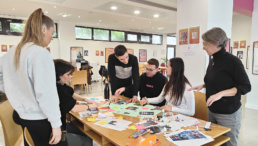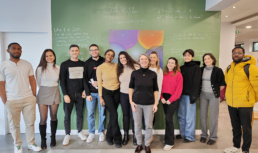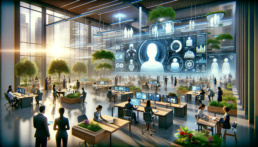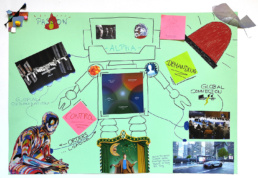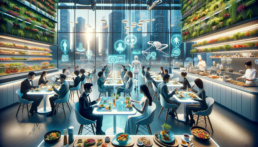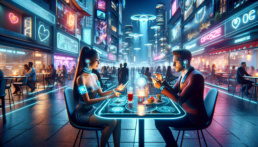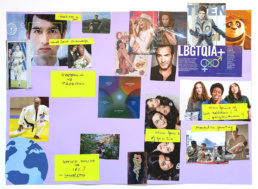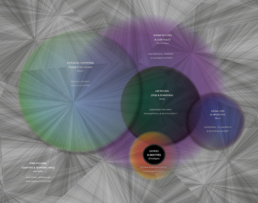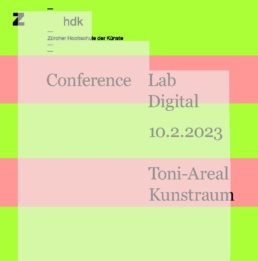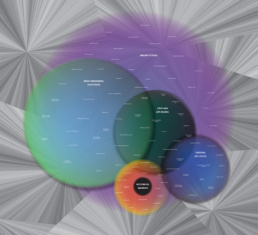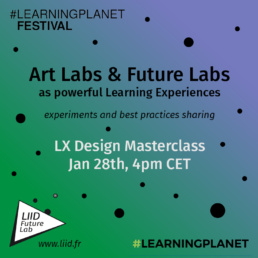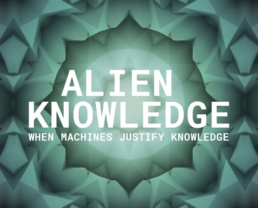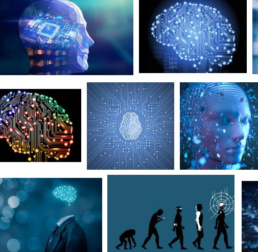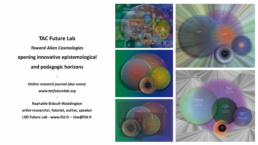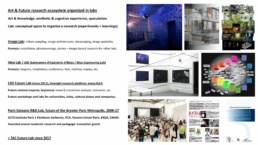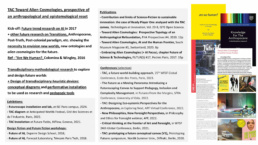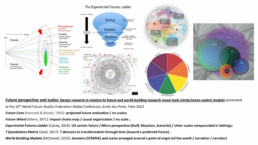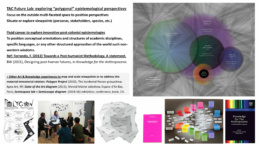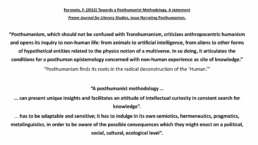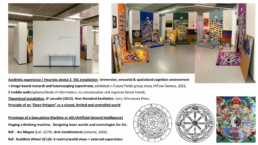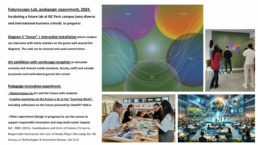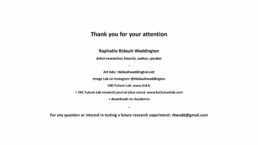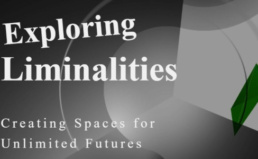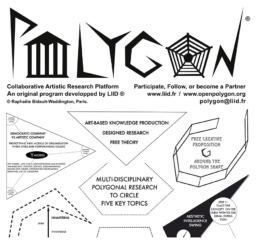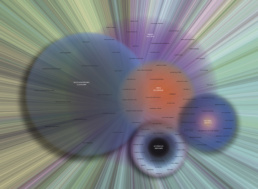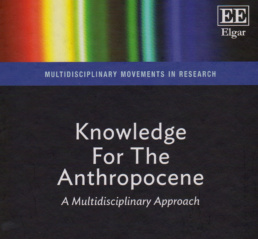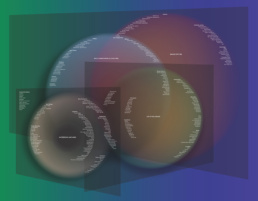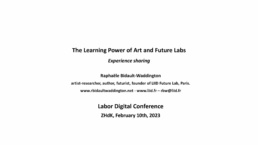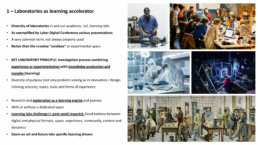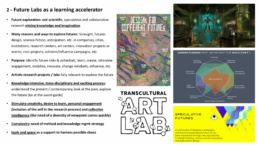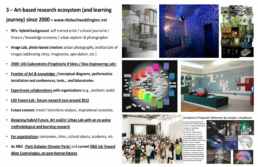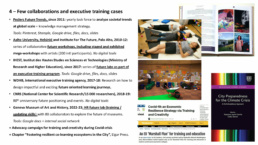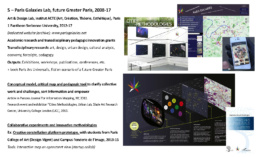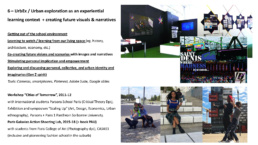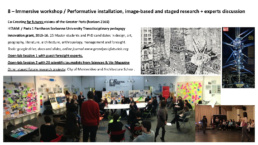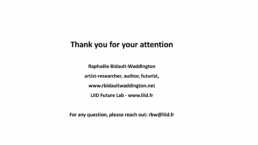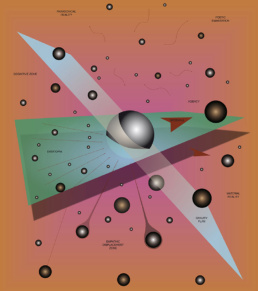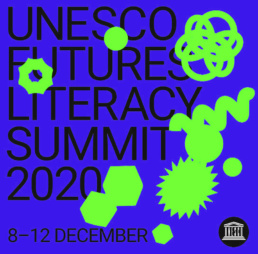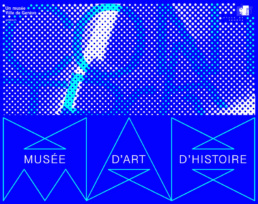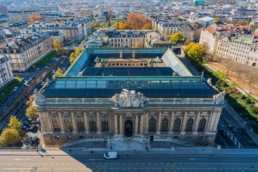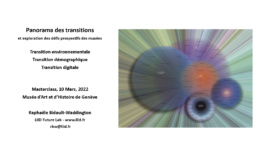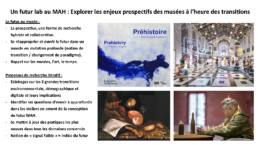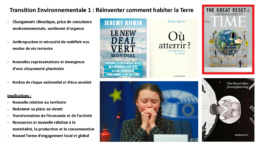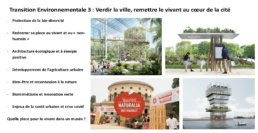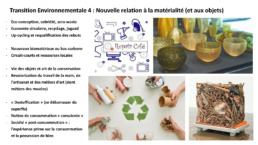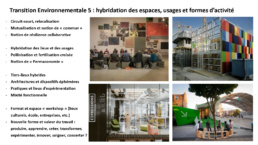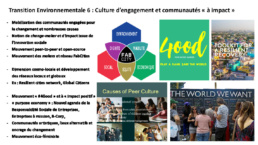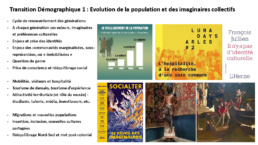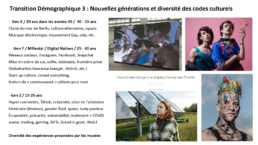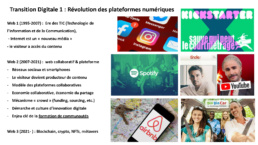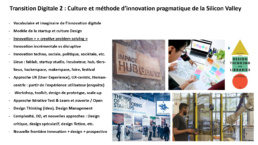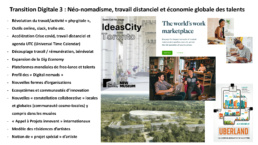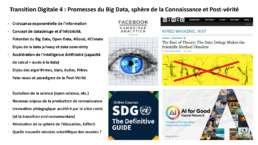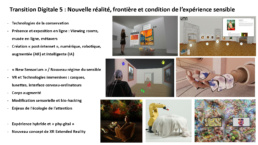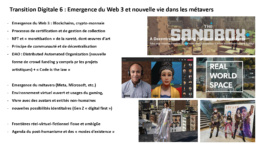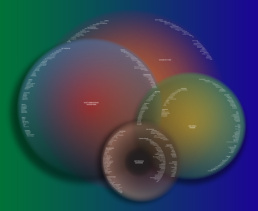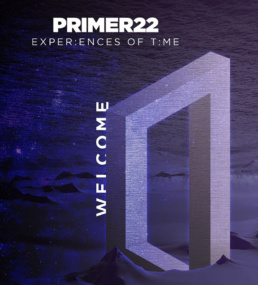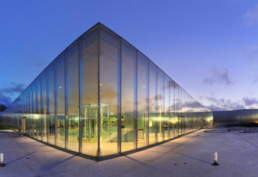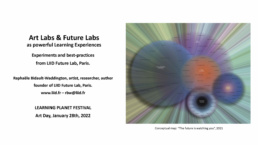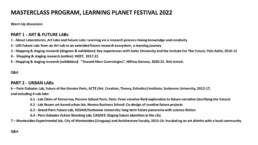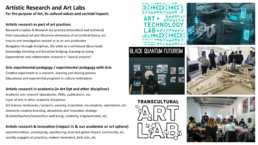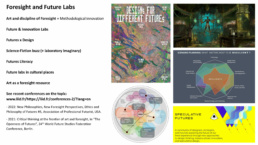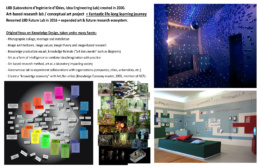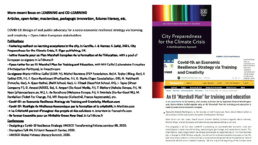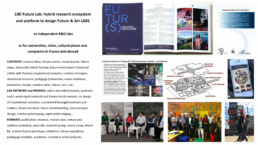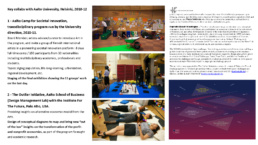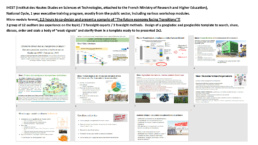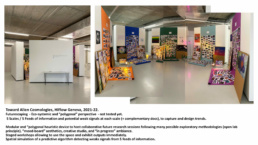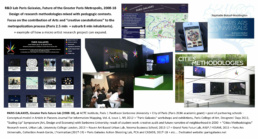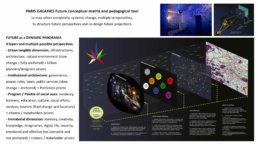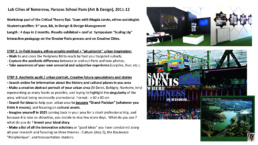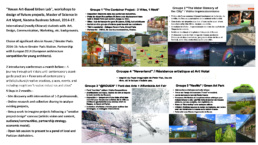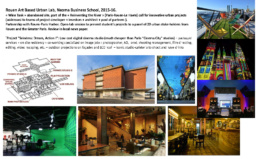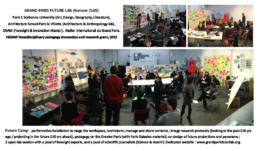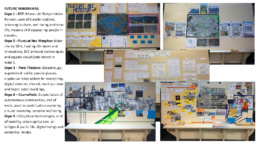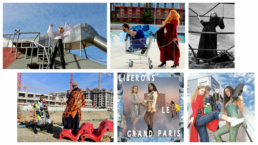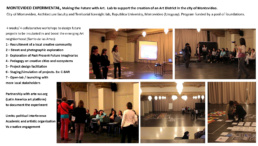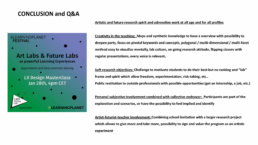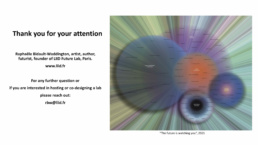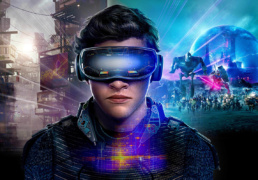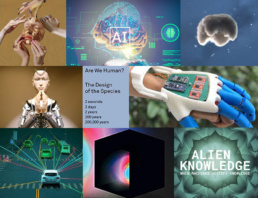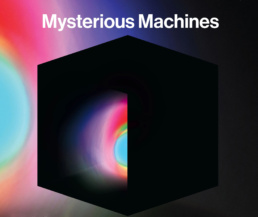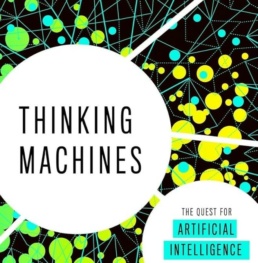Futurescape: Art x Future x Learning x IA, ISC Campus, Paris, 2023-24
Futurescape Lab
Art, Future and Pedagogical Innovation Experimentation
ISC Campus, Paris, 2023-2024.
This one year experimental program with ISC revolves around the exhibition of a new version of the TAC Future Canvas deployed here in the form of an interactive installation called Futurescape and exhibited in the school hall.-
The installation becomes a vehicle for a series of educational and prospective experiments carried out with students, professors, the school’s management team and its corporate and institutional partners - taking the form of masterclasses, workshops, publication, events and keynotes.
-
The Futurescape Lab workshop explored critical issues related to AI using the installation and working off images of the future generated by ChatGPT. A report of the experiment is published in the school's White Paper dedicated to AI and Learning.
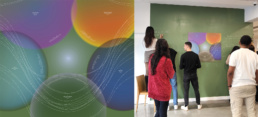
Présentation du projet
L’ISC est une école de commerce parisienne fortement positionnée et engagée sur la diversité et l’inclusion, ainsi que sur l’innovation pédagogique, notamment par son approche du Action Learning.
Conçu spécifiquement pour l’école qui souhaitait introduire une dimension artistique dans ses innovations, le projet Futurescape s’articulait autour d’une installation artistique et prospective exposée dans le hall de l’école et se déroulait en plusieurs séquences de fin 2023 à fin 2024.
L’installation comprend une nouvelle version du TAC Future Canvas avec toujours ses 5 sphères, accroché sur un grand mur peint en vert (couleur des tableaux d’école), sur lequel il est possible d’écrire au marqueur blanc.
En introduction du projet, le Masterclass « Art et Futurs Inclusifs », destiné aux étudiants du Master International (module pédagogique dirigé par Sabine Bacouel), permettait de montrer comment les expérimentations artistiques contribuent au futur et peuvent être des vecteurs d’innovation inclusive, notamment urbaine.
L’atelier Futurescape Lab (voir ci-dessous les détails), programmé pendant la Semaine de l’Apprendre de l’école, invitait les étudiants internationaux (niveau master), à explorer, en utilisant l’installation artistique, les enjeux de l’Intelligence Artificielle, grand thème de l’année de l’école.
Un long article paru dans le Livre Blanc de l’école a permis de mettre en lumière les bénéfices de l’expérimentation pédagogique, que ce soit : le principe de « futur lab » qui stimule l’engagement, l’imagination ou le désir de compréhension (donc de chercher de la connaissance et d’apprendre) ; la mise en scène et en espace de l’expérience qui permet d’avoir une bonne dynamique collective (action learning), de sortir du format du cours conventionnel, voire de transgresser le cadre de l’école (interdiction d’écrire sur les murs) ; le travail par l’image, le diagramme ou le grand format, qui permet de visualiser et de raisonner autrement ; la restitution publique des production à l’occasion d’un événement de l’école comme accélérateur de motivation pour faire un travail abouti ; etc.
Plusieurs événements à destination des entreprises partenaires de l’école rythmait l’année et ont permis de mettre en perspective et valoriser le projet parmi les innovations de l’école, tels que par exemple le partenariat stratégique avec le très prometteur Handilab, développé par la Fondation Fiminco à St Denis.
Atelier Futurescape Lab
L’atelier commençait par un temps de réflexion partagée sur l’ampleur des enjeux de l’IA grâce au diagramme qui permet d’appréhender l’ampleur des impacts et la bigger picture – et d’autant plus que ce diagramme est né d’une réflexion sur les enjeux prospectifs de l’IA, voir à ce sujet la genèse du TAC Future Lab.
Les étudiants étaient ensuite invités choisir des sous-thèmes, et à décrypter des images du futur de ces sous-thèmes produites par Chat GPT + Dall-e pour réfléchir à la vision du futur ‘imaginée’ par l’IA, affûter leur sens critique et gagner en discernement sur ses biais implicites.
Les trois sous-thèmes étaient : Future of Eating, Future of Work, et Future of Dating.
Venait ensuite un temps d’ouverture créative avec l’installation qui servait d’espace de brainstorming et de génération d’hypothèses prospectives sur le futur dans une vision élargie du monde, afin que les groupes croisent leurs étonnements, interrogations et idées. La possibilité de circuler dans l’espace, d’écrire sur le mur et d’échanger en toute liberté contribuait au décloisonnement de la réflexion.
Les groupes de travail avait ensuite pour tâche de construire une vision d’avenir de leur sous-thème sur de grandes planches visuelles, en se servant du TAC Future Canvas, d’images et d’informations recherchées en ligne.
Pour en savoir plus, télécharger l’article paru dans le Livre Blanc de l’école + qq images ci-dessous.
Research axes reminder
Axis 1: Transitions & Future Worlds
Axis 2: Foresight Methodology Innovation
Axis 3: Art & Future Research
Related articles
limit/no limit, Art & Design Research Conference, Paris, 2024
RBW zooms in on the TAC Future Lab work related to knowledge, whether it be the cognitive value of artistic formats,…
Designing Art-Based Future Labs, ZHdK, Zurich, 2023
RBW is invited to share the educational benefits of the experiments carried out in her various artistic, urban and…
Anticipated Worlds Festival, Cité of Sciences, Paris, 2022
The TAC Future Canvas here exhibited became a vast planisphere mapping the movements of the world toward alien…
Art & Future Labs as LX, Learning Planet Festival, 2022
RBW shared a wide range of artistic, urban and prospective research experiences (including TAC Future Lab), showing how…
Do They Dream of Electric Sheep?, Muzeum Susch, Switzerland, 2018
In this keynote, RBW shares her artistic and prospective reflections on the challenges raised by AI and the need to…
Future x IA x Speculative Design, Duperré Design School, Paris, 2018
In this workshop cycle on the future of/with AI, students discover the critical future challenges raised by AI, and…
limit/no limit, Art & Design Research Conference, Paris, 2024
TAC Future Lab
opening new epistemological and pedagogical horizons
limit/no limit, AD REC (Art&Design), ENSCI, ENS Saclay and Paris Sorbonne 1 and 3 Universities, Paris, 2024
This presentation is an opportunity to zoom in on questions related to knowledge addressed at TAC Future Lab.If the experiments carried out make it possible to demonstrate the pedagogical and transdisciplinary virtues of the TAC Future Canvas, the presentation emphasizes the production of knowledge through art, whether (as in our case) through image-based research (moodboards), diagrams or the design of installations that are artistic, performative and heuristic.
-
On the other hand, the current transitions raise many challenges in terms of knowledge (post-truth, AI, learning and education for sustainability, post-colonial pluriversalism, etc.); the ongoing anthropological refoundation process is fully coupled with a epistemological refoundation to apprehend the world and think of its futures. The TAC Future Canvas is meant to open new perspectives on the diversity of epistemological frameworks.
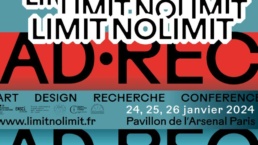
Abstract
Par son ampleur planétaire inédite, le contexte actuel de transitions multiples (monde VUCA, Deep Transition) est une invitation, si ce n’est une obligation, de repenser notre manière d’habiter la planète, de voir le monde et de nous projeter vers l’avenir. Comment refaire monde lorsque tous nos cadres anthropologiques et épistémologiques sont remis en question ?
A l’occasion de cette communication nous partagerons des éléments de recherche issus du TAC Future Lab (TAC pour Toward Alien Cosmologies – journal de recherche bientôt disponible sur tacfuturelab.org) menés depuis 2018. Son objectif est d’explorer comment concevoir de nouveaux mondes futurs dans une démarche d’innovation méthodologique transdisciplinaire mêlant prospective, art conceptuel, design, philosophie et pédagogie inclusive, parmi d’autres disciplines mobilisées dans les travaux du lab. Afin de s’émanciper des cadres épistémologiques conventionnels tout en respectant leur héritage et la possibilité de les relier, la création de nouveaux vocabulaires, architectures cognitives et ingénieries d’idées en est un point essentiel.
La démarche du lab inclue le design de diagrammes artistiques et méthodologiques, permettant d’ouvrir des espaces de recherche prospective radicalement transdisciplinaires et multidimensionnels (que nous appelons recherche polygonale), de croiser les savoirs et les points de vue, et d’explorer de nouvelles formes de monde. Ces dispositifs heuristiques, qui peuvent être spatialisés et mis en scène à l’occasion d’ateliers ou d’expositions, laisse leur place à l’imagination et à l’inconnu (ce que nous appelons le facteur alien), point sur lequel l’apport de l’art s’avère décisif et contribue à l’effort d’innovation pédagogique et d’empowerment du lab.
RBW
Intervention slides
A propos de limit/no limit, AD REC, Paris
La conférence limit/no limit, qui aura lieu du 24 au 26 janvier 2024 dans le cadre de Art Design Recherche Conference [AD•REC], invite les esprits créatifs, les chercheurs et les passionnés d’art et de design à se rassembler pour mener une réflexion sur la question de la limite dans le contexte de la recherche artistique et de la conception en France. Le comité scientifique a sélectionné 40 propositions sur plus de 150 qui reflètent une approche critique et réflexive, ainsi que des contributions qui présentent des exemples concrets de collaborations interdisciplinaires et résilientes.
Dans un monde façonné par la modernisation des sociétés et la diffusion rapide d’un modèle productiviste capitaliste mondialisé, cette conférence se veut une plateforme de réflexion critique et créative sur les défis sociétaux actuels. limit/no limit propose d’explorer différentes dimensions historiques et géographiques de la notion de limite, soulevant des questions cruciales.
Axes de recherche de la conférence :
1. RESSOURCES / La recherche en art et en design pour de nouvelles articulations entre communautés humaines et ressources naturelles.
2. SYSTÈMES / De quelle manière l’art et le design contribuent-ils à construire de nouveaux modèles de société ?
3. ÉPISTÉMOLOGIE / Comment l’art et le design contribuent-ils à la fabrication de nouveaux modes de savoirs ?
Site et programme de la conférence : limitnolimit.fr
Compte-rendu de toutes les inteventions sur le padlet de la conférence.
Research axes reminder
Axis 1: Transitions & Future Worlds
Axis 2: Foresight Methodology Innovation
Axis 3: Art & Future Research
Related articles
TAC World-building, 25th World Future Studies Federation Conference, Paris, 2023
This conference shows how the TAC Future Canvas was designed, how it rearticulates other tools and conceptual models…
Designing Art-Based Future Labs, ZHdK, Zurich, 2023
RBW is invited to share the educational benefits of the experiments carried out in her various artistic, urban and…
Artistic Research For Future Challenges, A2RU x Learning Planet Festival, 2023
Panel with artistic research actors who explored the many levers of creativity, build bridges between artistic…
Future visualization experiments, Exploring Next, Association of Professional Futurists, 2022
This intervention zoomed in on the artistic aspects of TAC Future Lab and presents in detail the TAC Future Canvas and…
Designing Post-Human Futures, Knowledge for the Anthropocene, 2021
This long essay lays the basis of TAC Future Lab methodological and transdisciplinary research, mixing learnings from…
‘Prototyping Futures’ Symposium, ‘Cybiosis’ Circle, NSU, Diffrakt, Berlin, 2020
This intervention was an opportunity to prefigure, share and discuss a first draft of the TAC Future Canvas, designed…
Designing Art-Based Future Labs, ZHdK, Zurich, 2023
Designing Art-Based Future Labs
closing keynote
Labor Digital International Conference, ZHdK (Arts Academy), Zurich, 2023
In this conference at the Art academy of Zurich, Raphaële Bidault-Waddington is invited to present her various artistic and future research laboratories and to show how they foster transdisciplinary knowledge production and sharing, facilitating learning through investigation and collaborative experimentation.-
Her R&D lab Paris Galaxies on the Future of Greater Paris has made it possible to prototype numerous methodologies from 2012 to 2017, whether through images, stories, projects or workspaces - including in the urban space which becomes a playground and learning terrain. Following this lab, TAC Future Lab has been experimenting with other exploratory modalities since 2017.
–
In the introduction, she reformulates a definition of the laboratory as a conceptual and fluid framework to structure and carry a research process around critical issues, using a diversity of methodologies and formats, that can be artistic, academic, prospective, innovative, or hybrid.
Presentation
Raphaele Bidault-Waddington, is the founder of LIID Future Lab, a foresight research platform designing future labs in artistic, academic, urban and corporate contexts.
From 2012 to 2017, its multi-awarded lab on the future Greater Paris metropolis (with Paris 1 Pantheon Sorbonne University) prototyped a series of mixed future research and transdisciplinary pedagogic innovations. Its latest R&D lab “Toward Alien Cosmologies” addresses post-human futures and continues innovating at the frontier of future research, art and co-learning.
Interview following the conference
What does the format of the lab/laboratory mean to you?
Historically laboratories were specific spaces where to access certain tools, make experiences or design and test experimental protocols in order to extract learnings, to innovate or to produce (scientific and non-scientific) knowledge. The concept of laboratory is in fact rather fluid. In a more recent time, other types of laboratories without specific tools and places, such as learning lab, urban labs, living lab, future lab, art lab, and so on, have emerged. Philosopher Bruno Latour has even introduced the idea that the real world should be the laboratory to learn directly from.
As an alternative definition, in the last twenty years, I have been using the notion of laboratory as a conceptual frame to design, organize and unfold a research process, geared toward a certain critical challenge or topic, and combining experiences or experiments, and learnings (knowledge production and sharing). These learnings can be considered scientific if the lab respect academic rules and protocols, and positions them in relation to a discipline’s state of the art. But they can also be hybrid, peri-scientific or non-scientific when other methods, experiments and knowledge formats are used.
The labs I create as an artist-researcher and future lab designer, always have a speculative dimension, and mix artistic, future, urban and transdisciplinary academic research methods, experiences and formats. Then a laboratory can be very short or very long (from one day to several years), evolve through time (different than a project or a production with a clear expected output), more or less open and collaborative, and involve a small or large number of participants.
What’s your favorite project that explores the future with a lab perspective?
My most thrilling project at the moment is the future lab “Toward Alien Cosmologies” that I started in 2017 to explore Artificial Intelligence future implications, and then expanded to the Anthropocene and post-Truth paradigms, which raise similar holistic future challenges. This lab is my most advanced future research where I’m trying to design new ways of exploring possible future worlds (cosmologies) when everything and at all scales, is radically uncertain.
The Anthropocene requires that we reinvent the way we live on Earth; AI (and technologies) challenges human capacities, certitudes, and politics and raise deep ontological issues; and the post-Truth shakes our relation and trust in any form of truth, as if everything has become somehow alien. This paradigm calls for a profound anthropological and transdisciplinary epistemological reset, which cannot be address with conventional rationality and that’s why and where Art is important. This lab is certainly not reasonable, in all the senses that term can take.
It also echoes post-humanist questions and philosophies as I develop in my article “Designing post-human futures” in Knowledge For the Anthropocene (E. Elgar Press, 2021).
A dedicated website, recollecting all the lab’s research episodes (workshops, exhibitions conferences and publications in France, US, Norway, Germany, Switzerland, etc.) since 2017 is due later this year.
Suite de l’interview sur le site du E-Learning Lab de ZHdK
Intervention slides
About Labor Digital Conference
The conference will explore the questions of which scientific and historical foundations today’s labs are based on. Which exploratory learning and teaching forms, which interdisciplinary methods are lab-specific and what potential does the digital laboratory have for inspired, critical thinking?
Will the learning of the future take place in labs? Can experimental, explorative learning with experts and peers facilitate innovative forms of teaching and learning?
What role does digitality play, and what artistic and design-oriented approaches are we developing in labs? And how can we integrate these methods as small interventions in teaching practice or use them as an entire teaching unit? We will explore these questions analytically and playfully at the LaborDigital conference.
Programme de la conférence : https://paul.zhdk.ch/course/view.php?id=2312#section-2
Compte-rendu de la conférence : https://elearning.zhdk.ch/experience/labordigital-experimental-learnings-an-der-zhdk-1
Research axes reminder
Axis 1: Transitions & Future Worlds
Axis 2: Foresight Methodology Innovation
Axis 3: Art & Future Research
Related articles
Futurescape: Art x Future x Learning x IA, ISC Campus, Paris, 2023-24
Artistic and prospective exploration program over a year including an interactive installation, experiential workshops,…
limit/no limit, Art & Design Research Conference, Paris, 2024
RBW zooms in on the TAC Future Lab work related to knowledge, whether it be the cognitive value of artistic formats,…
Art & Future Research, Alliance for Artistic Research in Universities, USA, 2022
RBW retraces the development of her laboratories, starting from their roots in the legacy of conceptual and…
Art & Future Labs as LX, Learning Planet Festival, 2022
RBW shared a wide range of artistic, urban and prospective research experiences (including TAC Future Lab), showing how…
Art x Futures, ‘Blended Futures’ Foresight Journal panel, UNESCO FL Summit, 2020
Drawing on a large scope of international examples, the presentation builds on how artistic productions have been…
Future x IA x Speculative Design, Duperré Design School, Paris, 2018
In this workshop cycle on the future of/with AI, students discover the critical future challenges raised by AI, and…
Future of Museums, Museum of Art and History, Geneva, 2022-23
Future of Museums and Transitions
Incubation of an internal future lab for the museum teams
Museum of Art and History, City of Geneva, 2022-23
The project consisted of initiating a prospective exploration process (future lab) within the museum teams, in order to shift perspectives, look at the future, help employees to take ownership of their future, support the definition of a new museum concept, and accompany current and future transformations.-
The first step was 'Panorama of Transitions', a masterclass with almost all the staff (80 people), which enabled participants to take a step back and start to collectively address the profound changes in progress and the future challenges museums are facing.
-
These challenges were then deepened in a ten months program of workshops that irrigated the museum's various activities and ambitions. The teams were trained to continue the work in complete autonomy.
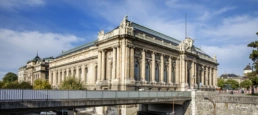
Présentation du projet
Situé au cœur de la ville, le Musée d’Art et d’Histoire de Genève est le 3e plus gros musée de Suisse, avec une collection de plus de 600 000 artefacts composés aussi bien d’œuvres d’art de différentes époques, que de pièces archéologiques, d’objets, d’armes, d’horlogerie, ou de numismatique. En choisissant un nouveau directeur issu de l’art contemporain, la Ville de Genève a souhaité donner un nouveau souffle à ce musée un peu vieillissant.
Le futur lab incubé a vocation à la fois à embarquer toutes les équipes du musée dans ce mouvement de réinvention audacieuse, et à nourrir la définition et le positionnement du nouveau concept muséal porté par la direction. L’objectif est de favoriser l’appropriation du futur par toutes les équipes en toute sérénité, et de soutenir la redéfinition du projet muséal et stratégique (en amont de toute communication), raison pour laquelle il s’est joué exclusivement en interne pour commencer.
Le masterclass introductif « panorama des transitions et enjeux prospectifs des musées » permettait à chacun de conscientiser le changement de paradigme actuel, et commencer à sentir et échanger sur comment les musées s’inscrivent dans ce monde en profonde transition. Le format masterclass (45mn de temps de parole, 45mn d’échanges à bâtons rompus avec le public) s’est avéré très efficace pour amorcer cette discussion collective (environ 80 participants).
Dans la foulée, les participants s’inscrivaient à un programme d’ateliers d’approfondissement prospectif dans les mois qui ont suivi, l’objectif étant qu’elles s’autoorganisent pour les poursuivre en toute autonomie. Par respect de nos engagements contractuels de confidentialité, nous ne divulguons pas les thèmes et contenus de ces ateliers prospectifs, dont certains sont très pragmatiques, appliqués ou stratégiques, d’autres plus spéculatifs, artistiques ou théoriques.
Le programme est accompagné de la mise en place d’outils de partage de connaissance et d’idées entre pairs, ainsi que d’un engagement et des modalités d’expérimentation régulière dans tous les départements du musées (conservation, programmation, services des publics, innovation, développement numérique, relations extérieures, gestion interne, etc.).
Des liens sont créés avec les autres programmes transverses ou extérieurs du musée (innovation, développement durable et urbain), ou encore avec le projet architectural associé au nouveau concept muséal en cours de définition.
Des points d’étapes réguliers permettent d’apporter des recommandations et d’affuter toutes ces modalités dans la plus grande fluidité.
Slides du masterclass introductif
Research axes reminder
Axis 1: Transitions & Future Worlds
Axis 2: Foresight Methodology Innovation
Axis 3: Art & Future Research
Related articles
Do They Dream of Electric Sheep?, Muzeum Susch, Switzerland, 2018
In this keynote, RBW shares her artistic and prospective reflections on the challenges raised by AI and the need to…
Towards Alien Cosmologies, prospective topology of a refoundation…, FHAP#4, 2020
This article offers a grand tour through the movements of the world and the critical future challenges they raise in…
Designing Post-Human Futures, Knowledge for the Anthropocene, 2021
This long essay lays the basis of TAC Future Lab methodological and transdisciplinary research, mixing learnings from…
Futures Fields exhibition, HiFlow, Geneva, 2021-22
Designed as an algorithmic ‘open polygon’ and as a speculative design experiment, the exhibited installation allowed…
Artistic & Polygonal Research on Time multidimensionality, PRIMER, 2022
Exploring the future also means questioning the temporal architectures and frameworks on which human life is…
Art, Innovation and Foresight Day, Louvre Lens Valley, 2024
Dedicated to the Louvre Lens innovation ecosystem, this ‘future lab’ day included three masterclasses on future and…
Art & Future Labs as LX, Learning Planet Festival, 2022
Art & Future Labs as Powerful Learning Experience (LX)
Experience sharing
Online masterclass, Learning Planet Festival, Learning Planet Institute, 2022.
During this interactive masterclass, RBW presented the educational aspects of her artistic, urban and prospective research laboratories, and showed how this type of exploratory practices, and more generally the 'lab culture', can be learning accelerators.-
The revaluation of this aspect of her experiences is part of a broader reflection on the role of training as a key lever for transitions and the making of the future, as well as on the future of learning in and outside the academic sphere.
-
The masterclass was organized in partnership with the LX Design MeetUp group, which fosters exchanges of best-practices between learning innovators in non-academic and inclusive contexts.
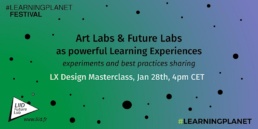
Webinar presentation on eventbrite
During this 90mn masterclass, Raphaële Bidault-Waddington, artist, researcher and founder of LIID Future Lab, will share a great diversity of artistic and future oriented experiments, showing how they become powerful learning experience (LX). Q&A will be taken for each presented case.
A broad scope of learning formats, contexts (school, academic research, work and culture) and profiles will be covered, from senior and highly educated executives, to Masters students or youth in difficulty, showing how, in all cases, a “creative lab” culture fosters learning desire, openness and empowerment. By definition, a “creative lab” thoroughly combines creativity, knowledge and experiment …
As a relaxed and discovery-oriented Friday afternoon, the discussion with participants will allow to collectively look for additional insights on creative pedagogy, futures literacy and LX innovation.
The zoom link is sent in the registration confirmation email.
Learning Planet Festival: https://festival.learning-planet.org/
Additionnal information: Tribune published by Raphaële Bidault-Waddington to advocate for training and creativity to tackle the Covid crisis in 2020: https://medium.com/@rbidaultwaddington/covid-19-an-economic-resilience-strategy-via-training-and-creativity-fffcd04b50f6
Intervention slides
Research axes reminder
Axis 1: Transitions & Future Worlds
Axis 2: Foresight Methodology Innovation
Axis 3: Art & Future Research
Related articles
Future x IA x Speculative Design, Duperré Design School, Paris, 2018
In this workshop cycle on the future of/with AI, students discover the critical future challenges raised by AI, and…
Future of Museums, Museum of Art and History, Geneva, 2022-23
This vast ‘future lab’ (10 months) on the future of museums has made it possible to sustainably instill prospective…
Artistic Research For Future Challenges, A2RU x Learning Planet Festival, 2023
Panel with artistic research actors who explored the many levers of creativity, build bridges between artistic…
Designing Art-Based Future Labs, ZHdK, Zurich, 2023
RBW is invited to share the educational benefits of the experiments carried out in her various artistic, urban and…
Art, Innovation and Foresight Day, Louvre Lens Valley, 2024
Dedicated to the Louvre Lens innovation ecosystem, this ‘future lab’ day included three masterclasses on future and…
Futurescape: Art x Future x Learning x IA, ISC Campus, Paris, 2023-24
Artistic and prospective exploration program over a year including an interactive installation, experiential workshops,…
Future x IA x Speculative Design, Duperré Design School, Paris, 2018
Future x IA x Design
a Speculative Design workshops cycle
ENS Design preparatory classes, Duperré Design School, Paris, 2018.
Hybridizing pedagogy and prospective exploration through Design Fiction and images, the workshop cycle led students to discover the future challenges raised by AI from a design perspective (AI Design), and then to imagine fictional situations giving life to one of the future fictions developed in our previous research step (with Paris Tech researchers).-
In this story, an AI delivers its personalized prescriptions in words and images, via an interface with which users develop a new and unprecedented relational proximity, far more complex than a simple functional interaction.
–
Using the means of their choice (image, ppt, videos, performance, etc.) the groups created very lively situations and simulations of that AI used in different fields (i.e. food, education, the environment, mobility, sport, dating and reproduction), showing its potentials as much as its deep ambivalence.
Introduction
Le cycle d’ateliers s’inscrit dans le cours de la designer Nounja Djamil avec qui le programme est coconçu et copiloté, se déroule en 5 séances sur une période de trois mois, et comprend un travail conséquent de recherche-création mené par les étudiants entre chaque séance.
En phase initiale, les étudiants découvrent les laboratoires de recherche artistique et prospective de RBW qui permettent d’apporter de la pédagogie sur la recherche par l’image, le futur et l’Intelligence Artificielle.
Son laboratoire d’image donne un exemple et permet de visualiser de comment réfléchir, spéculer, et développer des dispositifs, des concepts ou des narrations à partir de (ses) banques d’images photographiques – d’autres exemples et réflexions sur les banques d’images sont également présentés.
Son laboratoire d’idées (a.k.a LIID Future Lab) permet une première initiation d’une part à l’analyse de tendance par décryptage de « signaux faibles » (images et informations considérés comme des ‘signes du futur’), d’autre part au Design Fiction et à la conception de ‘prototype spéculatif’ pour donner à sentir des visions critiques du futur – avec l’exemple de « Paris Ars Universalis, scénario-fiction d’un futur Grand Paris ».
Enfin, le TAC Future Lab apporte des éclairages sur les enjeux de l’Intelligence Artificielle, ses principes algorithmiques et de machine learning (dont curation à partir de banques d’image), ou encore les imaginaires et les pratiques de design d’IA (pratiqué notamment chez Facebook).
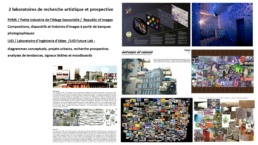
Pitch
Les 40 étudiants sont ensuite invités à s’approprier l’une des fictions futures développées par RBW avec les chercheurs de Telecom Paris Tech (voir étape de recherche dédiée), dans laquelle le CGG (Consortium Godel & Glitch) a développé une interface de recommandation personnalisée sur de nombreux sujets.
Cette IA est devenue un inestimable complice de tout un chacun, non sans une certaine ambiguïté dans les relations homme-machine et des implications bien plus complexes et existentielles, qu’une relation simplement fonctionnelle.
Chaque groupe (8 groupes de 5 étudiants) est invité à choisir un domaine d’application, à imaginer des artefacts/interfaces de recommandation par l’image, des personas et des situations spéculatives révélant les variations créatives potentielles ainsi que les enjeux critiques sous-jacents.
Les étudiants utilisent les médias créatifs de leur choix (curation online et moodboards, dessin, photomontage, vidéo, performance, etc.) pour partager leurs travaux.
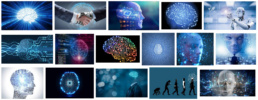
Conclusion
Les situations imaginées (voir ci-dessous) par les étudiants révèlent une excellente appropriation du pitch, créativité et investigation, ainsi qu’une bonne diversité d’angle d’approche. Elles oscillent entre des scénarios plus ou moins positifs, critiques et plausibles, en gardant un ancrage dans la réalité et avec un bon niveau de nuances et de détails.
Chaque ‘spéculation’ a ainsi donné lieu à de riches échanges avec et entre les étudiants, pour petit à petit dépasser l’échelle des situations explorées, conscientiser collectivement l’ampleur des implications de l’IA dans la société et le monde, et en saisir pleinement aussi bien les risques que les bénéfices.
L’approche par le design spéculatif a manifestement permis de dédramatiser les discours dominants (utopistes ou alarmistes) face à l’IA – et d’éviter l’écueil de la sur-dramatisation que l’on trouve souvent dans les méthodes de recherches prospectives inspirées de la Science-Fiction.
Aperçu des résultats
A l’issue du processus, les groupes présentaient leurs situations spéculatives à l’oral avec tous l’éventail de leurs matériaux de recherche projetés et/ou présentés sur tables, suivi d’une discussion collective. Nous donnons ici un résumé succinct de chaque groupe.
Le Groupe 1 se focalise sur les arts culinaires et la suggestion de recettes ‘tendances’ et personnalisées qui répondent aux besoins de chacun (calories, intolérances, restrictions, préférences, temps de préparation, etc.) mais permettent aussi de revaloriser les patrimoines gastronomiques du monde entier…
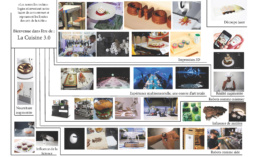
Le Groupe 2 adresse un sujet plus critique, celui de la reproduction assistée par IA, qui permet via un utérus artificiel et une IA qui sélectionne les meilleures séquences ADN, d’optimiser sa descendance et le design d’humains…

Le Groupe 3 se penche sur la ‘crise tactile’, et propose une IA ‘robot érotique’ qui d’une part aide et guide, aussi bien la main humaine que la main artificielle, pour apprendre à se toucher, se caresser ou se masser. Comme la vidéo réalisée le montre, cette guidance passe par un système d’éclairage coloré projeté sur les corps, qui indique de manière très subtile les zones, la diversité ou l’intensité des manipulations.
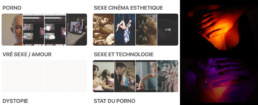
Le Groupe 4 imagine une IA,véritable activiste antiplastique, suggérant des modalités d’interventions que ce soit pour limiter la consommation d’emballage, faire évoluer les modes de fabrications, favoriser l’écodesign ou agir pour sauver les océans de la pollution plastique.
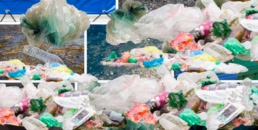
Le Groupe 5 s’intéresse à la difficulté d’optimiser les équations et solutions de mobilité urbaine, et propose un algorithme qui aide à arbitrer entre de nombreuses hypothèses multimodales, bien trop complexes pour l’entendement humain. Dans le cas du Grand Paris pris en exemple (avec un brin d’ironie), la tendance suggérée semble cependant étrangement simple avec le choix d’un méga métro appelé « Le Tube », semant le doute sur l’utilisation de l’IA par les politiques.
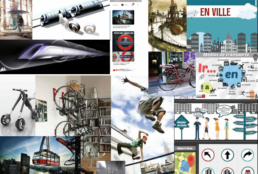
Le Groupe 6 imagine une interface de dating immersive et cinématographique, qui permet à des humains de se rencontrer et de flirter dans des univers virtuels, où ils viennent rejouer des séquences de leurs films préférés, comme étape préliminaire à une rencontre réelle…
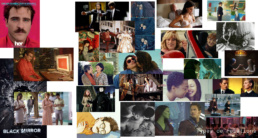
Le groupe 7 conçoit une interface d’’edutainment’ (education + entertainment) qui permet d’apprendre en jouant avec une IA. Cette interface se projette sur un mur pour éviter l’immobilisme et l’étroitesse de l’écran, et favoriser la mobilisation du corps dans le processus d’apprentissage. De très nombreux type de connaissances et de compétences sont possibles.
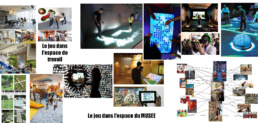
Le Groupe 8 propose une plateforme de recommandation de solution individuelle de mise en forme avec une approche très complète et boostée du corps : sport, fitness, soin, médecines alternatives, pharmacologie augmentée, data-analytics, quantify-self, chirurgie esthétique, body-enhancement, bio-hacking, design prothétique, etc. au risque d’un rapport au corps obsessionnel et à tendance post-humaine…
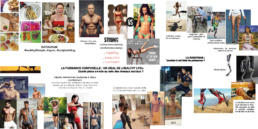
Research axes reminder
Axis 1: Transitions & Future Worlds
Axis 2: Foresight Methodology Innovation
Axis 3: Art & Future Research
Related articles
Futurescape: Art x Future x Learning x IA, ISC Campus, Paris, 2023-24
Artistic and prospective exploration program over a year including an interactive installation, experiential workshops,…
SF and Innovation: Analysis of Ready Player One, Tech & Innovation Review, 2023
In this article, the TAC Future Canvas is used to audit the innovations and vision of the world expressed in the film…
TAC, AI and the Human Frontier, Muzeum Susch Magazine, 2020
In this essay, RBW builds a bridge between the existential fear that gave its modernity to Heiddeger's thought in his…
Do They Dream of Electric Sheep?, Muzeum Susch, Switzerland, 2018
In this keynote, RBW shares her artistic and prospective reflections on the challenges raised by AI and the need to…
Future of Artificial General Intelligence, Forccast, Telecom ParisTech, 2018
Development for a research team, as part of their participation in the FORCCAST program, of a set of speculative short…
Toward Alien Cosmologies, FUTUR(S) Trend Report, Peclers, 2017
It is in the international and influential FUTUR(S) book that Raphaële Bidault-Waddington initially coined the notion…

